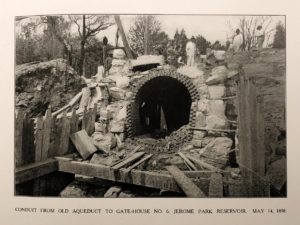
Let’s look this time at the tunnel half of the equation. After all, if there were no tunnel, there’d be no trail. But first it should be noted that the Old Croton Aqueduct, for much of its length, is basically “cut and cover” construction. No sweaty sandhogs bored tunnels hundreds of feet underground, as with the New Croton Aqueduct. No, when you walk or bike the Aqueduct trail today, the stone and brick conduit is just underfoot.
But this was no easy thing to build. It was a gravity-fed 41-mile conduit, and the Hudson Valley is anything but flat, so various ways had to be devised to traverse the many dips and bumps and keep the water flowing toward Manhattan at an average grade of just over 13 inches a mile. (That grade is sort of a sweet spot: any flatter, the water wouldn’t flow; any steeper, it would flow too fast and be hard to control.) When the terrain dipped, bridges had to be built, like the one just north of downtown Ossining. Just north of that, a hill loomed, necessitating a true tunnel. (Some tunnels had to go through rock.) And when skimming the side of a hill, extra reinforcement was needed.
These were among the vast challenges facing the engineers nearly 200 years ago, when New York City finally faced up to its desperate need for water. Their solution became one of the marvels of the age.
Not that the process was smooth: In 1835, the first chief engineer, David Bates Douglass, planned the route and structures and established the hydraulic principles to be used. But after various disputes with the city Water Commission — over costs and the huge, thorny task of acquiring the land — he was replaced a year later by John Bloomfield Jervis.
Jervis, who started out as a lowly worker on the Erie Canal and later built the Delaware and Hudson Canal and was chief engineer of the Hudson Line Railroad, is the true hero of this tale. He basically kept Douglass’s design and did the final design of the aboveground structures, but he made it all happen in an astoundingly short time: begun in 1837, the Aqueduct carried its first water to a joyful city a mere five years later.
What challenges did they face? To start with, deciding what materials to use and how big the passageway should be. One early idea was to have an open canal, with a wooden roof; this was rejected because it lacked protection from frost and contamination. The final design involved a horseshoe-shaped conduit, with brick-lined masonry walls, eight and half feet high and seven and a half feet wide.
You can see for yourself how well the tunnel has held up all these years on one of the many tours of the Ossining weir chamber we offer throughout the year.
And at the Keeper’s House Visitor Center in Dobbs Ferry, you can see a fascinating collection of early, rarely seen engineering drawings, many from the Jervis Library in Rome, N.Y. The exhibit, curated by Robert Kornfeld Jr., the Friends’ vice president, is called “The Tunnel: A Passage Through History” and is on view weekends from 1 to 4, through June.
Come to our annual meeting on April 7 at 2 at the Tarrytown Library for “Tales of Croton Point.” And for all things Aqueduct — maps, T-shirts, tours, events, and more — go to aqueduct.org.






Pretty cool part of New York history